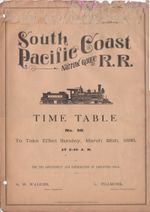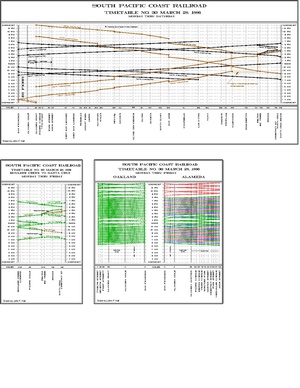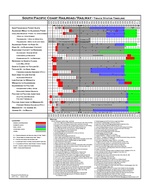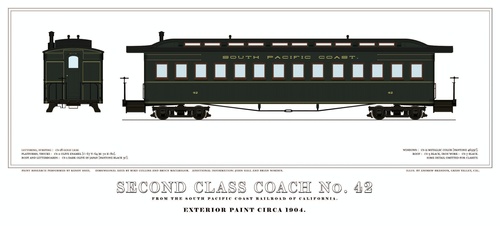South Pacific Coast Railroad
This page is under construction
Contributors: John F. Hall;
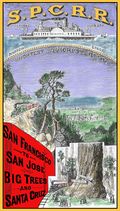
The South Pacific Coast Railroad was incorporated on March 20, 1876.[1] It operated until May 21, 1887 when it and it's various leased lines were consolidated into the South Pacific Coast Railway.[2] The SPCRwy stock was sold and transferred to Leland Stanford, Charles Crocker and Collis Huntington on August 1, 1887[3] . These gentlemen then leased the SPCRwy to the Southern Pacific Railroad Company. The information on this page is for the independent 1876-1887 South Pacific Coast Railroad.
Brief Description
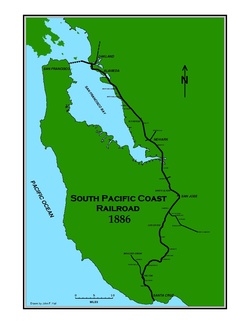 A trip on the three foot gauge South Pacific Coast Railroad began in San Francisco where two ferry slips on the south side of the ferry building at the foot of Market Street served the railroad. One slip was for passenger travel and the other was for freight. Three ferryboats, the Newark, Bay City, and Garden City operated between the San Francisco Ferry building and Alameda. Between 1878 and 1884 the Alameda ferry terminal was at Alameda Point. In March 1884 a new Alameda passenger ferry terminal opened out in the Bay via a 2.75 mile long trestle.[4] Freight continued to be handled at the Alameda Point freight ferry slip.
A trip on the three foot gauge South Pacific Coast Railroad began in San Francisco where two ferry slips on the south side of the ferry building at the foot of Market Street served the railroad. One slip was for passenger travel and the other was for freight. Three ferryboats, the Newark, Bay City, and Garden City operated between the San Francisco Ferry building and Alameda. Between 1878 and 1884 the Alameda ferry terminal was at Alameda Point. In March 1884 a new Alameda passenger ferry terminal opened out in the Bay via a 2.75 mile long trestle.[4] Freight continued to be handled at the Alameda Point freight ferry slip.
From Alameda the railroad skirted the east side of San Francisco Bay to San Jose passing the communities of Alvarado, Newark, Alviso, and Santa Clara. From San Jose the railroad began its trek over the Santa Cruz Mountains with a gentle grade up Los Gatos Creek passing Campbell's and Los Gatos before traveling through the first tunnel and tackling the steeper grade to Wright's. At Wright's the railroad passed through a 6,157 foot tunnel to Highland (later Laurel) and through a 5,793 foot tunnel to Glenwood. Then traversing a short tunnel came out on Zayante creek where it traveled downgrade passing through another short tunnel before reaching Felton. Crossing the San Lorenzo River at Big Trees it joined the Santa Cruz and Felton Railroad for the trip down the narrow San Lorenzo River canyon to Santa Cruz passing through three more tunnels along the way. Two major branches were constructed. One between Felton and Boulder Creek and the other between Campbell's and New Almaden.
The railroad carried commuters between San Francisco and Oakland and Alameda. Passenger trains between San Francisco and Santa Cruz carried daily passengers. On Sunday excursion trains carried as many as 2000 people from the cities to the Santa Cruz Mountains and the Beach.
Freight shipments included redwood lumber, cordwood, ties, telegraph poles, grape stakes, shingles, shakes, lime, empty lime barrels, oil, fuel oil, coal, beer, grain, flour, paper, rags, paper pulp, bones, vegetables, fruit(fresh and canned), powder, gravel, machinery, sugar beets, sugar, stone, brick, hay, stoves, bitumen, rolling stock, street cars, cable cars, locomotives, and a ship.
Corporate History
South Pacific Coast Railroad Company
Incorporated March 20, 1876, [1] Newark to Big Trees, 44.9 miles[5]
The South Pacific Coast Railroad, as constructed and operated between March 1876 and May 1887, was composed of a conglomeration of seven separate railroads each with a separate corporate identity and stock holders. As a new section was built a new corporation was formed usually with either a Board of Directors similar to the South Pacific Coast Railroad or with a Board made up of South Pacific Coast Railroad employees. The first section to start construction was the South Pacific Coast Railroad between Dumbarton Point/Newark and Big Trees in the Santa Cruz mountains. This railroad was built upon the bones of the bankrupt Santa Clara Valley Railroad.
The Santa Clara Valley Railroad was an attempt to create competition with the Southern Pacific’s peninsula line from San Francisco to San Jose. San Jose farmers were fed up with the SP’s monopoly and high freight rates. Attempts to build a railroad between San Jose and Alviso, with shipping via water to San Francisco, were unsuccessful as unbeknownst to everyone the Southern Pacific in 1871 had quietly purchased the shipping rights from all of the south bay landings.[6] The SCVRR was organized by farmers, outside capitalists, and real estate speculators of the proposed town of Newark to bypass the south bay landings and build a narrow gauge railroad between a landing at Dumbarton Point, on the east side of San Francisco Bay, and Santa Cruz via San Jose.[7] The initial construction between Dumbarton Point and Santa Clara began in October 1975 and continued through the fall and winter. As construction was started so did the law suits from local property owners. The suits included an injunction to stop construction of a drawbridge on Dumbarton Point.[8]As grading got underway a contract for ties was signed with a supplier in the Santa Cruz mountains dependent on the newly opened Santa Cruz & Felton Railroad. The winter of 1875-1876 was a wet one. In December numerous slides closed the SC&FRR and the tie order could not be shipped.[9] The rains also washed out the newly graded roadbed of the SCVRR. The Baldwin Locomotive that was ordered had arrived and payment was due.[10] The Carter Brothers had begun construction on rolling stock with payment due on delivery.[11] By the end of January 1876 it was clear that the SCVRR was bankrupt. Attempts at new financing had failed.[12]
In Steps Some Mysterious Capitalists.
As the Santa Clara Valley Railroad was heading towards bankruptcy Alfred E. Davis was home in San Francisco having recently completed a three year contract for supplying and managing a fleet of wagons and teams to haul charcoal and ore for the mines of Eureka, Nevada.[13][14] The completion of the Ruby Hill Railroad had made his freighting business obsolete. Just a year earlier he had sold his stock in the Ophir mine in Virginia City. He was one of the original stockholders in 1862 [15]and sold the stock at a sharp increase in value.[16][17] Back home A. E. Davis was wealthier and looking for a new venture to invest in. The movement of freight had been an interest of Mr. Davis ever since his May 1849 arrival in San Francisco when he had to earn his living by borrowing a cart and renting a mule to move freight around the city. What he later found out was that he could earn significantly more money moving freight than panning for gold.[17]
In the late January 1876 rumors began circulating that the SCVRR debts were being paid and the locomotive was sold. On February 4, 1876 A. E. Davis and B. B. Minor checked into the Auzerais House Hotel in San Jose where the offices of the Santa Clara Valley Railroad were located.[18] Butler B. Minor was a civil engineer with a reputation of assisting businesses getting started. He was often appointed the Secretary of new corporations. The majority of them were mines.[19][20][21][22][23][24][25][26] He was also a stockholder of the Newark Land Company.[27] On February 13, 1876 the San Jose Daily Mercury reported that the Santa Clara Valley Railroad had a new Board of Directors: H. Bartling, President and General Manager; A. E. Davis, Treasurer; B. B. Minor, Secretary, George Kidd and Carey Pebbles, Directors. The home office remained in San Jose but the Treasurer's office moved to San Francisco. The report further said that the contract for the locomotive had been paid and rails had been ordered.[28] A. E. Davis seems to have stepped in to rescue the SVCRR.
A month later on March 20, 1876 the South Pacific Coast Railroad is incorporated with the following Board of Directors: Alfred E. Davis, President and Treasurer; Joseph Clark, Vice President, an attorney; Edward Barron, a capitalist; Seth Cook, a capitalist; George Kidd, a capitalist and President of the Bank of Stockton; J. Barr Robertson, a stock holder in the SCVRR and the Newark Land Company as well as the Agent for the California Land Investment Company; and Cary Pebbles, a former Director of the SCVRR and a strawberry farmer.[1] The capital stock of the SPCRR was established at 10,000 shares with the required 10% initially subscribed. Alfred Davis owned 994 shares of SPCRR stock and the others owned one share each.[29] With an infusion of capital the South Pacific Coast Railroad rose from the ashes of the SCVRR with a mission, "to build a railroad from Dumbarton Point through the counties of Alameda, Santa Clara, and Santa Cruz, on the most practicable route to the town of Santa Cruz with branch lines to Saratoga and New Almaden."[1]
Alfred E. Davis was the first person mentioned in the press associated with the SPCRR. However the press dismissed Mr. Davis as a major owner[30] and began speculating about the "real" owners of the railroad. The railroad's checking account was with the Nevada Bank and the offices were in the new Nevada Bank building on Montgomery Street, San Francisco. The newspapers initially assumed that the newly crowned Bonanza Kings: Fair; Flood; MacKay; and O'Brien were backing the railroad.[31][32] It had to be someone with lots of money because the railroad did not ask for any government subsidy or donation of land. No one was stepping forward to take the credit and the newspapers continued to speculate.[33] However, some facts were beginning to be revealed. A. E. Davis admitted in an interview that as of April 1879 he had put $700,000 of his own money into the SPCRR[34] and Edward Mix the road's construction engineer stated that A. E. Davis was a one fourth owner.[35] But just who the other owners were, and who was in control, were still mysteries.[36][37]
Through 1878 the Board remained the same with the same stock holders. In 1879 two things happened: George Kidd died, his stock was held in probate for a year; and a new California State Constitution was approved establishing a Railroad Commission. Reports to the new Commission were not required for the year 1879. The 1880 report to the Railroad Commission reported that all 10,000 shares of the SPCRR stock had been subscribed to 7 unnamed stockholders. Sometime between December 1878 and December 1880 the remaining 9000 shares of stock were sold. Future information suggests that A. E. Davis bought 1500 shares, creating his one fourth share in the company, and James C. Flood, and James G. Graham each purchased 3750 shares of SPCRR stock.[38] Fair and Flood were silent partners giving control to A. E. Davis as the number of reported stockholders had not increased, the seven directors were known, and they did not include either Flood or Fair.[39][40] James Fair may have bought his SPCRR shares in October 1879 after Alfred Davis gave him a tour of the railroad.[41] Similarly James C. Flood may have bought his shares after an August 1880 tour with Davis.[42]
It would seem that with A. E. Davis's 2494 shares of SPCRR stock and Fair's and Flood's 3750 each shares that Fair and Flood would have been in control. But there is more to control than just stock in the SPCRR. By June 1879 A. E. Davis owned 98 percent of the Santa Cruz and Felton Railroad stock.[43][44] He also probably still controlled the stock of the Bay & Coast Railroad. Without the SC&FRR and the B&CRR the South Pacific Coast Railroad had no northern or southern connections. Therefore with his 2494 shares of SPCRR stock and control of the SC&FRR and the B&CRR Davis controlled the entire railroad. It also helped that Fair and Flood did not like each other and were unlikely to pool their resources.
| Thomas Carter | Apr 1876[45] - Aug 1880[46] | Construction Superintendent[47] |
| Frank W. Bowen | Aug 1880[46] - Sep 1881[48] | Resigned to become Vice-President of the Excelsior Powder Co.[49] |
| Albert. H. Fracker | Sep 1881[48] - Oct 1883[50] | Asked to Resign[51] |
| George Revett | Oct 1883[50] - Jan 1884[52] | Resigned after argument with A. E. Davis[51] |
| Alfred E. Davis | Jan 1884[52] - Mar 1884[53] | Filled in until Luther Fillmore arrived.[54] |
| Luther Fillmore | Mar 1884[53] - Jun 1887 | Continued as the Superintendent of the SPCRwy |
Settling Down to Operation
In 1880 when the railroad fully opened between San Francisco and Santa Cruz there was a change in the officers of the company. B. B. Minor left and George H. Waggoner took his place as Secretary. Mr. Waggoner was A. E. Davis's nephew-in-law having married Alfred's brother Sam's daughter Louisa.[55] George Waggoner had first been the General Passenger Agent during the time the railroad operated only north of Wright's when the big tunnel was being dug. There was also a change in the Board of Directors. Issac E. James had taken the place of the deceased George Kidd and Daniel Cook had taken the place of his brother Seth. Issac James was a mine superintendent in Virginia City, Nevada.[55] He was also a Director of the Virginia & Truckee Railroad as well as its Chief Engineer.[56]Richard M. Garratt was no longer needed to separately superintend the Santa Cruz and Felton Railroad once the tunnels were completed. He became the SPCRR General Freight Agent. Briefly, George Waggoner wore two hats additionally filling the General Passenger Agent role.
When 1881 rolled around the board had one minor change. J. Barr Robertson stepped down as Director and John Rosenfeld took his place.[39] Rosenfeld was a consignment merchant and had been a Director of the Newark Land Company.[57] R. M. Garratt became the General Freight and Passenger Agent. In late 1882 Daniel Cook died but that just meant that his brother Seth would return to the board after the usual year long probate of Daniel's will. Isaac James left the Board to be replaced by J. E. Jones of Virginia City and later Tombstone, Arizona. A new director was added to the Board, Charles Iverson.[58] Charles was the SPCRR Bookkeeper/Chief Accountant. It seems that A. E. Davis may have been trying to consolidate his power on the Board. Then in 1883 Cary Peebles died and R. M. Garratt took his place.[58] Finally in 1884 R. M. Garratt left the Board and no one replaced him.[59]
James G. Fair Takes Control
The Leased Lines
During the 1880's California Law allowed the forming of a corporation if there were five Directors, each owning a minimum of one share of stock, and ten percent of the stock had been subscribed. Therefore a $1,000,000 corporation with shares costing $100 each could be formed with only 1000 shares subscribed.[1] One man could own all but four shares with the other four Directors owning only one share each. The corporation would be able to start business with one man in control and 9,000 shares available for further sale. Furthermore the law allowed that future assessments could be placed upon the shares. If the assessments were not paid the shares could be put up for auction for the cost of the assessment and the costs of the sale. The typical use of the assessment was to require subscribed shareholders to pay the latest installment on non fully paid up shares. However in practice the assessment was often used to extract money from paid up shareholders in order to further the business or pad the pockets of the major stockholders. The practice of assessing paid up shares continued until July 1882 when Charles Spreckels won his California Supreme Court challenge of the Santa Cruz Railroad's assessment on his shares.[60]
 A. E. Davis created a new corporation with its own stock, officers, and directors for each extension of the The South Pacific Coast Railroad Company. These corporations were then leased to the SPC railroad; although lease terms and rentals were never established.[61] The SPCRR leased lines were: the Bay and Coast Railroad Co.; the Oakland Township Railroad Co.; the San Francisco and Colorado River Railroad Co.; the Felton and Pescadero Railroad Co.; the Santa Cruz and Felton Railroad Co.; the Almaden Branch Railroad Co.; and the Alameda and San Joaquin Railroad Co. which was surveyed but never built.
A. E. Davis created a new corporation with its own stock, officers, and directors for each extension of the The South Pacific Coast Railroad Company. These corporations were then leased to the SPC railroad; although lease terms and rentals were never established.[61] The SPCRR leased lines were: the Bay and Coast Railroad Co.; the Oakland Township Railroad Co.; the San Francisco and Colorado River Railroad Co.; the Felton and Pescadero Railroad Co.; the Santa Cruz and Felton Railroad Co.; the Almaden Branch Railroad Co.; and the Alameda and San Joaquin Railroad Co. which was surveyed but never built.
Bay and Coast Railroad Company
Incorporated May 2, 1877[62], Alameda to Newark 24.8 miles[5]
Directors: Alfred E. Davis, President and Treasurer, 996 shares; Joseph Clark, Vice-President, 1 share; B. B. Minor, Secretary; Daniel Cook, Director, 1 share; J. C. Tucker, Director, 1 share; Edward Barron, Director, 1 share. Capital 1,000,000 in shares of $100 each.[63][62]
The Bay and Coast Railroad extended between Newark and the Alameda Point Ferry Terminal. A franchise from the Town of Alameda was necessary to place steam railroad tracks on the city streets. The application for the franchise was requested by Dr. J. C. Tucker, a local physician. It was a practice of A. E. Davis to have a prominent citizen request the franchise. The May 1877 franchise was approved quickly as Alameda was very happy to get direct ferry service to San Francisco.[64]
Oakland Township Railroad Company
Incorporated January 7, 1881[65], Alameda to Oakland 4.1 miles[5]
Directors: Alfred E. Davis; Daniel Cook; Seth Cook; Joseph Clark; and Edward Barron. [66]
The purpose of the the Oakland Township Railroad was to serve Oakland and pass through the City over its northern boundary near Telegraph Avenue and Thirty-sixth Street or the western boundary near San Pablo Avenue and Adeline Street.[66] This proved to be a very difficult undertaking. Over six years, five franchises were requested of the Oakland City Council. Two were approved and built for steam railroad.[67][68][69] One franchise was approved for a cable car on Grove street which was not built.[70] One was approved for steam power on Fallon street but not built.[71] The request for steam power on Telegraph Avenue between Broadway and the City Limits was not adopted by the City Council.[69] An additional franchise was adopted by the Alameda County Board of Supervisors for tracks across the Webster Street bridge.[72]
The result was that between June 1881 and July 1886 the SPCRR crossed San Antonio Creek (the Oakland/Alameda Estuary) on a newly built Webster Street Bridge and traveled up Webster Street to Twelfth Street. Service to Fourteenth Street was by horse car as the original franchise did not allow steam power north of Twelfth Street. Then tracks were relocated across the block of Franklin Street, Webster Street, 13th Street, and 14th Street with the depot on Franklin Street near Fourteenth Street and in July 1886 a new franchise extended steam service to the depot.[73]
The Oakland Railroad, which was purchased as separate property of James G. Fair to provide the connection out of Oakland, rebuilt the five foot gauge horsecar line along San Pablo Avenue into a cable car line.[74][75] It also rebuilt the horsecar along Telegraph Avenue from a single track five foot gauge to a dual track three foot gauge in anticipation of a steam railroad franchise through the City of Oakland.[76] The franchise was not approved due to property owner disapproval. However SPC Locomotive No. 1 was loaned to the Oakland Railroad and pulled out to the City Limit near Temescal by horses to serve as motive power on Telegraph Avenue between Thirty-sixth Street and the State University at Berkeley.[77] SPCRR freight cars and relief locomotives were also pulled out to Thirty-sixth Street by horse power.[78][79] The Oakland Railroad remained separate property of James Fair and was not included in the consolidation of railroads into the South Pacific Coast Railway.[2]
For an expanded history see the Oakland Township Railroad.
San Francisco and Colorado River Railroad Company
Incorporated January 16,1883[65], Projected Length:650 miles.[80] Constructed Length:Alameda Mole to Alameda Point 3.0 miles.[5]
Directors: A. E. Davis, SPCRR President; A. Groves, SPCRR Freight Clerk; Charles Iverson, SPCRR Bookkeeper; George C. Prentice, SPCRR Clerk; R. M. Garratt, SPCRR, General Passenger and Freight Agent. With a capital stock of $20,000,000 divided into $100 shares. A. E. Davis was the Treasurer with ten percent of the stock paid in.[80]
Felton and Pescadero Railroad Company
Incorporated January 13, 1883[65], Felton to Boulder Creek 7.3 miles[5]
Directors: A. E. Davis, G. H. Waggoner, R. M. Garrett, Charles Iverson, W. T. Fitzgerald with a capital stock of $500,000: Davis $46,000; Waggoner, $1,000; Garrett, $1,000; Iverson. $1,000; and Firzgerald, $1,000.[81][82]
Leased to the SPCRR
Replace Flume. Originally tried to go thru downtown Felton
Santa Cruz and Felton Railroad Company
Incorporated November 13, 1874[65], Santa Cruz to Felton 7.1 miles[5]
Include Flume may need to change corporate name.
Over 100 stockholders
Assessment auctions - shares purchased by Davis
For an expanded history see the Santa Cruz and Felton Railroad.
Almaden Branch Railroad Company
Trains began running June 1886.[83] Incorporated April 6, 1887[65], Campbell's to New Almaden Station 9.6 miles[84]
Alameda and San Joaquin Railroad Company
Incorporated September 1881, Directors: George D. Prentice, SPCRR clerk; Ayscough Groves, SPCRR freight clerk; James L. McCarthy, First Officer ferryboat Garden City; Charles Iverson, SPCRR bookkeeper; and William T. Fitzgerald, SPCRR ticket clerk.[85] by the most practicable route through Alameda, Contra Costa, San Joaquin, Stanislaus, Merced, Fresno, Tulare, and Kern counties.[86]
Survey only
Consolidation to the South Pacific Coast Railway Company
The Transfer to New Owners
Consolidation to the SPCRwy 50 year Mortgage of the road, rolling stock, floating stock, buildings, land, appurtenances for 5.5million in Bonds Give the bonds to the SCPRwy stockholders who then give their stock to Stanford, Crocker, Huntington who then lease road to the SP. Bonds and interest are then paid off from the operating profits of the SPCRwy which is why the SPCRwy had to stay in business until 1937.
Fair's Oakland street railroads.
Ancillary Corporations
Pacific Land Investment Company
Incorporated April 28, 1876, Directors: Alfred E. Davis, Edward Barron, Seth Cook, Joseph Clark, and J. Barr Robertson.[87]
The Pacific Land Investment Company was incorporated to handle all of the real estate purchases and sales of land related to the South Pacific Coast Railroad. A major land investment was the town of Newark and its surrounding acreage. The other major concern was the purchasing of the right-of-way for the railroad and the subsequent sales of excess right-of-way. Some of that excess right-of-way was in the Town of Alameda where some property owners would only sell their entire lot even if the railroad only needed a small portion. This excess land was subdivided. The company built and later sold homes on the new lots. Samuel Davis, Alfred E. Davis's brother was the land agent for the Newark property.[55] John L. Romer was the land agent for the railroad.
The Pacific Land Investment Company was not included with the consolidation of railroads into the South Pacific Coast Railway
Bay and Coast Telegraph Company
Incorporated June 1878
Directors: Alfred E. Davis, President; Edward Barron; Daniel Cook; Joseph Clark; and Seth Cook. Capital $100,000 in shares of $100 each.[88][89]
The Bay and Coast Telegraph Company was not included with the consolidation of railroads into the South Pacific Coast Railway
Construction
Stations and Line Side Industry
San Francisco Ferry Building
The Ferry Building at the foot of Market Street was the SPCRR San Francisco landing for passengers, wagons with teams, and freight cars. The two southern most ferry slips were designated for the SPCRR. The southern one was used for the freight ferry boat Garden City. Photographs do not exist that show the layout of the freight car tracks on the wharf but the description in the newspapers was a seventy foot long two track apron to the ferry connected to two connected turntables with radiating tracks for loading/unloading of the freight cars. Freight cars were hoisted off the ferry using a deck-mounted winch on the Garden City with a system of pulleys on the wharf. [90][91] Once on the wharf the cars were moved by horses.[92]
Alameda Ferry Terminal
Alameda Point
Operation
Passenger
Commuter Service $.015 (1880 dollars) with inflation $3.77 (2020 dollars)
BART Embarcadero station from Lake Merritt station $3.70, from MacArthur station $3.95
Through train Parlor Car service an additional $0.50
Excursions
Freight
Lumber, lime, cordwood, ties, brick, grain, flour, hay, fruit (fresh and canned), produce, sugar, oil, fuel oil, machinery, stoves, rolling stock, stone, gravel, coal, beer, paper pulp, paper, molasses (SPCRwy), locomotives, ships, sugar beets, bitumen.
Crossings and Interchanges
The SPCRR crossed Southern Pacific railroads five times. At each crossing the South Pacific Coast was required to stop before crossing.
- In Oakland
- Seventh Street - SPC/SP Double track crossing double track
- First Street - SPC/SP Double track crossing double track.
- In Alameda
- Pacific Avenue - SPC/SP Double track crossing single track
- In Santa Clara
- Single track crossing SPC/SP
- In Santa Cruz
- Two single track crossings SPC/SP
Mention crossing protections
The Tunnels
A total of ten tunnels were dug between Los Gatos and Santa Cruz. Eight were dug by the South Pacific Coast contractors and two by Santa Cruz and Felton Railroad contractors. In 1880 when the SPCRR opened between Los Gatos and Santa Cruz eight tunnels were in use. Of the other two, one collapsed shortly after construction and the other was abandoned after a new lower, straighter, and larger tunnel was dug.
| No. | Location | Built By | Year Open | Original Length[93] | Note |
|---|---|---|---|---|---|
| none | 1 mile south of Los Gatos | SPCRR | 1878 | 185 feet | Collapsed February 1878 and became a cut.[94] |
| 1 | 1.4 miles south of Los Gatos | SPCRR | 1878 | 191 feet | |
| 2 | Between Wright's and Highland | SPCRR | March 1880[93] | 6,157 feet | Multiple deadly explosions during construction due to natural gas deposits. |
| 3 | Between Highland and Glenwood | SPCRR | October 1879[95] | 5,793 feet | |
| 4 | South of Clem's | SPCRR | December 1878[96] | 913 feet | 2 men killed during construction |
| 5 | 0.5 miles north of Doughtery's | SPCRR | February 1879[97] | 250 feet | |
| 6 | 1 mile south of Big Trees | SPCRR | December 1879[98] | 338 feet | |
| none | 0.25 miles south of Rincon | SC&FRR | August 1875[99] | 125 feet | Abandoned October 1879 |
| 7 | 0.25 miles south of Rincon | SPCRR | October 1879[100] | 282 feet | Built slightly to the west and below the SC&FRR tunnel reducing the curvature and grade and increasing the height.[101] |
| 8 | Misson Hill, Santa Cruz | SC&FRR | October 1876[102] | 918 feet |
Locomotives
South Pacific Coast Railroad Locomotive Roster
Rolling Stock
Passenger Cars
Freight Cars
Ferryboats
Newark
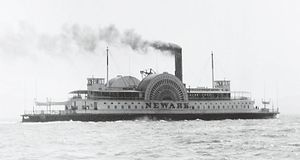 Launched: April 25, 1877[103]
Launched: April 25, 1877[103]
Engineer's Trip:June 13, 1877[104]
In Service: for excursions July 22, 1877[105]; for scheduled service:June 1, 1878[106]
286' x 43' beam, hold 12 1/4'[103]
1500 horse power cylinder 65" diameter with 12' stroke[103]
Paddleboxes: 42' diameter[103]
Bay City
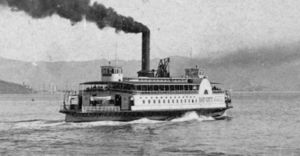 Launched: May 18, 1878[107]
Launched: May 18, 1878[107]
In Service: approx July 8, 1878[108]
258' x 40' beam hold 13'[107]
50" cylinder 12' stroke[107]
Property of Bay and Coast Railroad[107]
Garden City
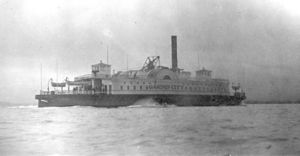 Launched: June 21, 1879[109]
Launched: June 21, 1879[109]
In Passenger Service: July 4, 1879[110]
San Francisco wharf completed without rails: December 17, 1880[111]
Winch installed on deck of Garden City: March 18, 1881[112]
SF wharf rails completed, Freight Service begins: March 24, 1881[113]
208' x 37' beam hold 13 1/2'[114]
46' cylinder with 12' stroke. Freight car capacity: 14 cars[115]
No upper cabin for passengers.
Encinal
Passenger and Freight boat, tracks on deck
Ordered by the South Pacific Coast Railroad and delivered to the South Pacific Coast Railway
Reference Material Available Online
Photographs
Collected South Pacific Coast Railroad Photographs.
Images collected from private collections, libraries and historical societies.
Maps
The South Pacific Coast Railroad ca. 1886 for Google Earth By John Hall
Trackage
A timeline of track life, including: construction, service dates and gauge changes.
Color Cards
Color swatches using PMS color representing the paint layers found on the carbody.
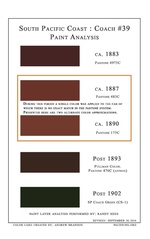 Color Card: South Pacific Coast - Coach #39 by Andrew Brandon
Color Card: South Pacific Coast - Coach #39 by Andrew Brandon
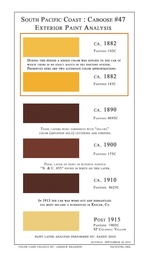 Color Card: South Pacific Coast - Caboose #47 by Andrew Brandon
Color Card: South Pacific Coast - Caboose #47 by Andrew BrandonOrganizations
Society for the Preservation of Carter Railroad Resources. Dedicated to the preservation of equipment built by the Carter Brothers and other car builders of the west coast.
Further Reading
MacGregor, Bruce A., South Pacific Coast, Howell-North 1868
MacGregor, Bruce A., Narrow Gauge Portrait South Pacific Coast, Glenwood 1975
MacGregor and Truesdale, A Centennial South Pacific Coast, Pruett 1982
MacGregor, Bruce A., The Birth of California Narrow Gauge, Stanford 2003
MacGregor, Bruce, The Centennial History of Newark, Newark Days 1876
Holmes, Norman W., Prune Country Railroading, Shade Tree 1985
Hamman, Rick, California Central Coast Railways, Pruett 1980
Shaw, Fisher, Highland, Oil Lamps and Iron Ponies, Bay Books 1849
Ford, Robert S., Red Trains in the East Bay, Interurban 1977
McCaleb, Charles S., Surf, Sand & Streetcars, Interurban 1977
Harlan, George H., Ferryboats, Howell-North 1967
Bruntz, George G., History of Los Gatos, Valley 1971
Elliott, W. W., Santa Cruz County California Illustrations with Historical Sketch, Elliott 1879
Thompson & West, Historical Atlas Map of Santa Clara County, 1876
Thompson & West, Historical Atlas Map of Alameda County, 1878
References
- ↑ 1.0 1.1 1.2 1.3 1.4 Proffatt, John; The Law of Private Corporations, 1876, pages 208-210
- ↑ 2.0 2.1 Daily Alta California, May 26, 1887, page 6
- ↑ Daily Alta California, August 2, 1887, page 1
- ↑ Oakland Daily Evening Tribune March 15, 1884, page 5
- ↑ 5.0 5.1 5.2 5.3 5.4 5.5 South Pacific Coast Narrow Gauge R. R. Timetable No. 30, March 28, 1886
- ↑ San Jose Daily Mercury September 16, 1874, page 3
- ↑ San Jose Daily Mercury October 5, 1875, page 3
- ↑ Daily Alta California December 26, 1875, page 1
- ↑ Oakland Daily Evening Tribune December 4, 1875, page 3
- ↑ San Jose Daily Mercury January 23, 1876, page 4
- ↑ Daily Alta California November 6, 1875, page 1
- ↑ San Jose Daily Mercury January 9, 1876, page 3
- ↑ Eureka Daily Sentinel July 25, 1875, page 3
- ↑ Sacramento Daily Union June 19, 1872, page 3
- ↑ Sacramento Daily Union December 18, 1862, page 2
- ↑ The Daily Appeal January 14, 1875, page 3
- ↑ 17.0 17.1 Contemporary Biography of California’s Representative Men, Bancroft, 1881, page 219
- ↑ San Jose Daily Mercury February 4, 1876, page 3
- ↑ Daily Alta California October 29, 1871, page 1
- ↑ Daily Alta California May 26, 1872, page 1
- ↑ Daily Alta California June 28, 1872, page 1
- ↑ Daily Alta California July 26, 1872, page 2
- ↑ Pacific Rural Press August 2 1873, page 80
- ↑ Daily Alta California September 17, 1873, page 1
- ↑ Daily Alta California August 29, 1874, page 2
- ↑ Daily Alta California March 14, 1875, page 2
- ↑ Daily Alta California March 14, 1875, page 2
- ↑ San Jose Daily Mercury February 13, 1876, page 3
- ↑ Report of the Board of Commissioners of Transportation to the Legislature of the State of California, December 1877, page 212
- ↑ Oakland Daily Evening Tribune July 17, 1878, page 2
- ↑ Santa Cruz Sentinel September 30, 1876, page2
- ↑ San Jose Weekly Mercury, November 9, 1876, page 3
- ↑ Oakland Daily Evening Tribune June 4, 1878, page 2
- ↑ Santa Cruz Sentinel April 12, 1879, page 2
- ↑ Santa Cruz Sentinel July 12, 1879, page 2
- ↑ Santa Cruz Sentinel October 16, 1880, page 3
- ↑ Oakland Daily Evening Tribune March 19. 1884, page 3
- ↑ San Francisco Chronicle December 22, 1885, page 5
- ↑ 39.0 39.1 Third Annual Report of the Board of Railroad Commissioners of the State of California 1882, page 324
- ↑ Oakland Daily Evening Tribune February 13, 1886, page 1
- ↑ Santa Cruz Sentinel October 18, 1879, page 3
- ↑ Santa Cruz Sentinel August 28, 1880, page 3
- ↑ Oakland Daily Evening Tribune June 17, 1879 page 2
- ↑ Daily Alta California May 25, 1887, page 2
- ↑ Oakland Evening Tribune April 29, 1876, page 3
- ↑ 46.0 46.1 Oakland Daily Evening Tribune August 19, 1880, page 3
- ↑ Oakland Evening Tribune April 29, 1876, page 3
- ↑ 48.0 48.1 Santa Cruz Sentinel August 13, 1881, page 3
- ↑ Santa Cruz Sentinel September 3, 1881, page3
- ↑ 50.0 50.1 Oakland Daily Evening Tribune September 7, 1883, page 3
- ↑ 51.0 51.1 San Francisco Chronicle January 24, 1884, page 3
- ↑ 52.0 52.1 San Francisco Chronicle January 23, 1884, page 2
- ↑ 53.0 53.1 Daily Alta California February 28, 1884, page 4
- ↑ Oakland Daily Tribune February 18, 1884, page 2
- ↑ 55.0 55.1 55.2 1880 U. S. Census
- ↑ Reno Evening Gazette May 11, 1881 , page 3
- ↑ Sacramento Daily Union December 18 1874, page 3
- ↑ 58.0 58.1 Fifth Annual Report of the Board of Railroad Commissioners of the State of California, 1884
- ↑ Seventh Annual Report of the Board of Railroad Commissioners of the State of California, 1886
- ↑ Santa Cruz Sentinel July 15, 1882, page 4
- ↑ Seventh Annual Report of the Board of Railroad Commissioners for the State of California for the Year Ending December 31, 1886, 1887, page 383
- ↑ 62.0 62.1 Biennial Report of the Commissioner of Transportation of the State of California for the years ending 1877 and 1878, 1879, page 414
- ↑ Oakland Daily Evening Tribune August 17, 1877, page 3
- ↑ Santa Cruz Weekly Sentinel May 5, 1877, page 3
- ↑ 65.0 65.1 65.2 65.3 65.4 Ninth Annual Report of the Board of Railroad Commissioners of the State of California for the year ending 1888, 1889, page 290
- ↑ 66.0 66.1 Oakland Daily Evening Tribune January 7, 1881, page 3
- ↑ Daily Alta California, March 7, 1880, page 1
- ↑ Daily Alta California February 25, 1886, page 8
- ↑ 69.0 69.1 Oakland Daily Evening Tribune, June 25, 1886, page 3
- ↑ Oakland Daily Evening Tribune September 22, 1885, page 3
- ↑ Daily Alta California, March 4, 1879, page 1
- ↑ Oakland Daily Evening Tribune December 22, 1879, page 3
- ↑ Oakland Daily Evening Tribune, July 12, 1886, page 4
- ↑ Daily Alta California August 20, 1885, page 4
- ↑ Daily Alta California November 22, 1886, page 1
- ↑ San Francisco Chronicle February 10, 1886, page 4
- ↑ Oakland Daily Evening Tribune, June 29, 1886, page 3
- ↑ San Francisco Chronicle July 29, 1886, page 8
- ↑ Alameda Semi-Weekly Argus February 19, 1887, page 3
- ↑ 80.0 80.1 Sacramento Daily Record-Union January 17, 1883, page 3
- ↑ Sacramento daily Record-Union June 16, 1883, page 8
- ↑ San Jose Daily Mercury June 24, 1883, page 2
- ↑ Oakland Daily Evening Tribune June 7, 1886, page 4
- ↑ South Pacific Coast Railroad Timetable No.33 April 2, 1887
- ↑ Daily Alta California September 13, 1881, page 2
- ↑ Livermore Herald Septembeer 15, 1881, page 3
- ↑ Oakland Evening Tribune May 6, 1876, page 3
- ↑ Sacramento Daily Record-Union June 11. 1878, page 3
- ↑ Langley's San Francisco Directory, April 1879, page 116
- ↑ Alameda Argus January 27, 1881, page 3
- ↑ Alameda Argus March 17, 1881, page 3
- ↑ San Jose Herald November 20, 1879, page 3
- ↑ 93.0 93.1 Santa Cruz Sentinel March 27, 1880, page 2
- ↑ Santa Cruz Sentinel February 23, 1878, page 2
- ↑ Oakland Daily Evening Tribune October 11, 1879, page 2
- ↑ Santa Cruz Sentinel December 28, 1878, page 3
- ↑ Santa Cruz Sentinel February 22, 1879, page 3
- ↑ Santa Cruz Sentinel December 27, 1879, page 3
- ↑ Santa Cruz Sentinel August 21, 1879, page 3
- ↑ Santa Cruz Sentinel October 4, 1879, page 3
- ↑ Santa Cruz Sentinel July 26, 1879, page 3
- ↑ Santa Cruz Sentinel October 7, 1876, page 3
- ↑ 103.0 103.1 103.2 103.3 Daily Alta California April 26, 1877, page 1
- ↑ Daily Alta California June 14, 1887, page 1
- ↑ San Jose Daily Mercury July 24, 1877, page 3
- ↑ San Francisco Chronicle June 13, 1878, page 4
- ↑ 107.0 107.1 107.2 107.3 Daily Alta California May 19, 1878, page 2
- ↑ Oakland Daily Evening Tribune July 8, 1878, page 1
- ↑ San Francisco Chronicle June 21, 1879, page 3
- ↑ Alameda Argus July 3, 1879, page 3
- ↑ Daily Alta California December 17, 1880, page 1
- ↑ Alameda Argus March 17, 1881, page 3
- ↑ Alameda Argus March 31, 1881, page 3
- ↑ Daily Alta California June 25, 1879, page 2
- ↑ Alameda Argus June 26, 1879, page 3



